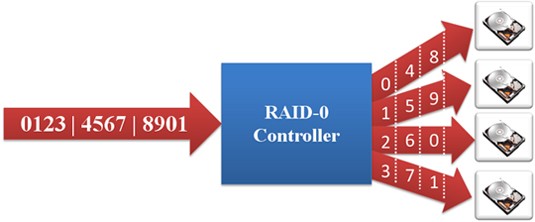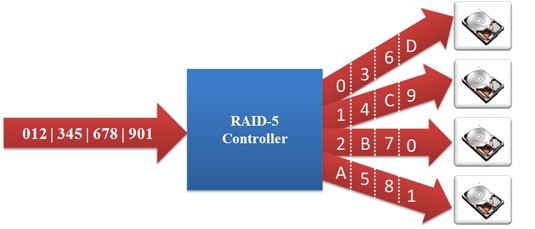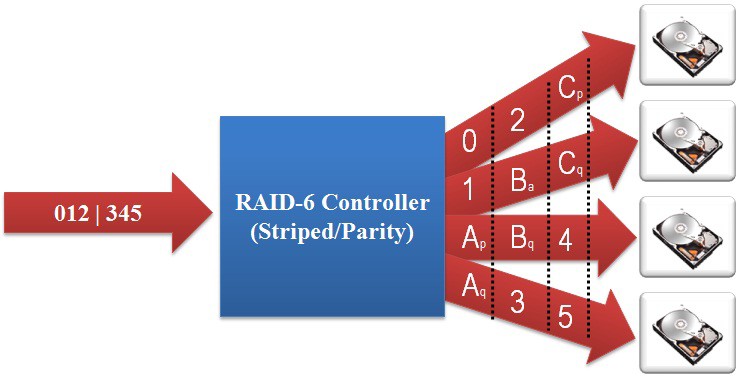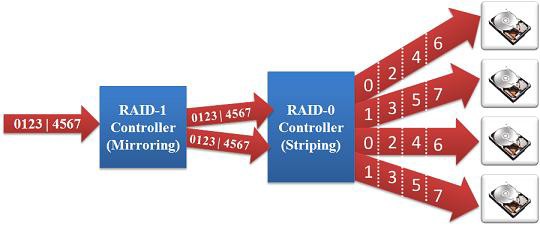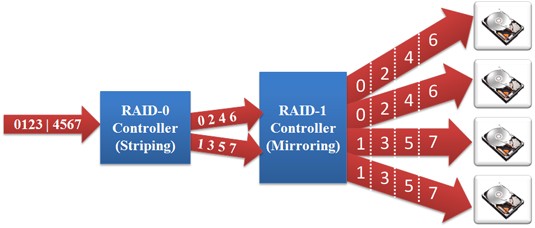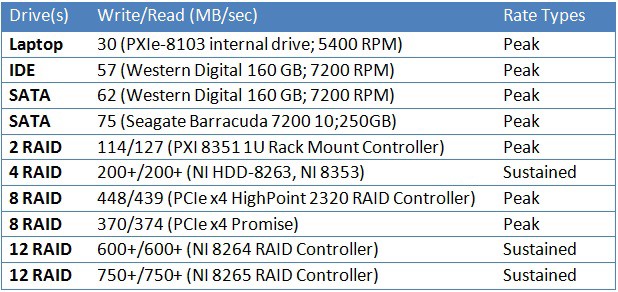Understanding RAID Levels, Configurations & More
Overview
Contents
- Different RAID Configurations
- Different RAID Levels
- Sample Benchmarks
- National Instruments RAID Solutions
- Conclusion
Different RAID Configurations
One of the bottlenecks for data streaming is the read/write speed of the actual hard drive. As data is being written to a hard drive, the movement of the disk head, as well as the bus speed for the hard drive, limits the rate at which data can be transferred to the physical disk. This factor is the main limitation to streaming rates with single hard drive systems. RAID arrays combines a number of hard disks into one logical unit through hardware or software transparently. The array looks like a single drive to the user as well as the operating system.
Different RAID Levels
RAID 0: Striped Set without Parity (Requires Minimum 2 Disks) – Data is equally divided into fragments across a number of disks. The maximum read and write rates of the RAID array is theoretically equal to the number of drives in the array and the read and write rate of an individual drive. This is because the data is equally split and written to or read from all disks simultaneously. While this is the fastest RAID configuration, if any one drive fails, the entire array is corrupted and no data can be recovered.
RAID 1: Mirrored Set (Requires Even Number, Minimum 2 Disks) – Focuses only on redundancy. Data is mirrored across all the drives in the RAID array. The read and write performance of a array configured as RAID 1 is the same as the read or write performance an individual drive. The array however offers the highest reliability as it continues operates as long as one drive is functioning.
RAID 5: Striped Set (Requires Minimum 3 Disks) with Distributed Parity – Parity information is stored on the drives allowing the reconstruction of the array if one disk fails. The parity information is rotated through all disks. Performance increase is just below RAID 0 but increased fault protection makes RAID 5 an ideal choice over RAID 0.
RAID 6: Double distributed parity. Similar to RAID 5 it stripes blocks of data and parity across an array of drives like RAID 5, except that is calculates two set of parity information for each set of data. RAID 6 can withstand multiple drive failures.
RAID 1+0 (also called RAID 10):
RAID levels can be nested in order to increase performance while providing redundancy. RAID 1+0 mirrors the data first, and then stripes them. This allows for a performance increase, with the added feature of fault tolerance.
RAID 0+1 (RAID 01):
RAID 01 is similar to RAID 10 except that the RAID levels are reversed. RAID01 stripes the data first and then mirrors them. The performance increase is similar to that of RAID0, with the added feature of redundancy.
The following table summaries the different RAID configurations.
| RAID mode | Min. number of drives | Description | Advantages | Disadvantages |
| 0 | 2 drives | Data striping | Fastest speeds | Data is lost if one drive fails |
| 1 | 2 drives | Disk mirroring | Highest reliability | No read or write performance improvement |
| 5 | 3 drives | Block-level data striping with distributed parity | Very fast speeds and high reliability, best performance vs reliability compromise | Write speeds slower than RAID 0 |
| 6 | 4 drives | Block-level data striping with double distributed parity | Can withstand multiple drive failures | Writes speeds slower than RAID 5 |
|
1+0 0+1 | 4 drives | Combination of mirroring and striping | Fast speeds and high reliability | High costs, minimum of 4 drives required |
Sample Benchmarks
Following table compares the maximum write and read rates for various hard drives and RAID arrays. All RAID arrays were configured as RAID 0. Numbers marked as peak show outer rim rates that cannot be sustained across the whole drive/array.
National Instruments RAID Solutions
National Instruments offers the 4-drive HDD-8263, 4-drive NI 8260, and 12-drive HDD-8625 and HDD-8264 RAID solutions for PXI Express systems. The HDD-8263 can be configured for RAID levels 0, 1, 5 and 1+0. It has a sustained throughput of 200MB/s and has a capacity of 1TB. The NI 8260 can be configured for RAID 0 and JBOD. It has a sustained throughput of 200MB/s and has a capacity of 1 TB when using platter hard drives. The NI 8260 also has the option of solid-state drives as well. The HDD-8264 can be configured for RAID level 0. It has a sustained peak throughput of 600MB/s and capacity of 3TB. The HDD-8265 can be configured for RAID levels 0, 1, 1+0, 5, and 6. It has a sustained peak throughput of 750MB/s and comes in either 6TB or 12TB storage capacity sizes. All of National Instruments’ RAID drives are designed to fit in a 19 inch wide rack with the HDD-8263 being 1U in height and the HDD-8264/5 2U in height. The NI 8260 is 3U designed to fit into a PXI Express chassis taking up three slots.
NI RAID solutions and rackmount controllers use enterprise class hard drives for high performance and data integrity.
Conclusion
RAID is an effective mass storage scheme for improving speeds for streaming application purposes and increasing redundancy to ensure data safety. RAID 0 is best suited for applications that require high-speed data streaming. RAID5, RAID1+0 and RAID 0+1 are suitable for applications that require a combination of high-speed steaming and redundancy. RAID 1 is best for applications that are not speed intensive but require high data integrity.
